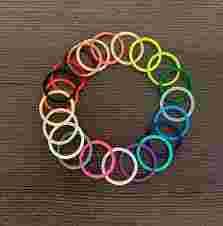Colored jump rings are an essential component in jewelry-making, chainmaille, and other craft projects. These small yet versatile rings not only serve as connectors between beads, charms, and chains but also add a vibrant touch of color and style to your creations. Choosing the right colored jump rings is crucial for both functionality and aesthetic appeal. This guide explores everything you need to know about selecting the perfect style and finish for your projects.
What Are Colored Jump Rings?
Jump rings are small loops of metal that are typically cut and formed into circles. Colored jump rings are available in a variety of materials and finishes, including anodized aluminum, enameled copper, stainless steel, and plated brass. The color options range from subtle metallic tones to bold, vibrant hues.
These rings are commonly used to:
-
Connect charms and pendants.
-
Create chainmaille jewelry.
-
Link beads in necklaces, bracelets, and earrings.
-
Add decorative accents to craft projects.
By choosing colored jump rings, artisans can match their designs, create patterns, or even contrast colors for a striking visual effect.
Factors to Consider When Choosing Colored Jump Rings
1. Material
The material of the jump ring determines its strength, flexibility, and durability. Common options include:
-
Aluminum: Lightweight and easy to work with, available in a wide range of colors through anodizing. Ideal for chainmaille and large projects.
-
Copper: Stronger than aluminum, often plated or enameled for color. Offers a classic metallic look.
-
Stainless Steel: Very durable and resistant to tarnish, often available in silver or black finishes. Best for long-lasting jewelry pieces.
-
Brass: Affordable and sturdy, usually plated with gold or other colors for decorative purposes.
Choosing the right material depends on the type of project and how much wear the jump rings will endure.
2. Color and Finish
Colored jump rings are available in various finishes:
-
Anodized: Aluminum jump rings are anodized to produce vibrant, long-lasting colors that resist fading.
-
Plated: Brass or copper rings can be plated with gold, silver, or other metals to achieve a metallic sheen.
-
Enameled: Rings coated with enamel offer a smooth, colorful finish that can add a bold statement to your jewelry.
Consider your project’s design and color palette when selecting jump rings. Coordinating colors can create a cohesive look, while contrasting colors can make certain elements stand out.
3. Size and Gauge
Jump rings come in different diameters (size) and wire thicknesses (gauge). These factors affect both the appearance and strength of the ring:
-
Diameter: Smaller rings are delicate and suited for fine jewelry, while larger rings are better for statement pieces or chainmaille patterns.
-
Gauge: Thicker wire provides more strength but can be harder to manipulate, whereas thinner wire is easier to open and close but may be less durable.
Choosing the correct size and gauge ensures your jump rings can handle the weight of beads, charms, or other components without bending or breaking.
4. Shape and Closure Type
While most jump rings are circular, some projects may benefit from oval or uniquely shaped rings.
-
Round Jump Rings: The most common, ideal for general jewelry-making and chainmaille.
-
Oval Jump Rings: Better for linking multiple components or creating certain chainmaille weaves.
Additionally, the closure type matters: fully closed jump rings provide maximum strength, while open jump rings are easier to manipulate but must be securely closed to prevent components from slipping out.
5. Quantity and Cost
Colored jump rings are often sold in bulk, and the cost can vary depending on material, size, and finish. Consider your project’s scale when purchasing to avoid running out mid-way. Buying in bulk is generally more economical, especially for large projects or frequent crafting.
Tips for Working with Colored Jump Rings
-
Use the Right Tools: Needle-nose pliers or specialized jump ring pliers make opening and closing rings easier without damaging the finish.
-
Avoid Overstretching: Repeatedly opening and closing rings can weaken the metal and cause it to break.
-
Match Metal Types: For durability and aesthetic consistency, use jump rings made of the same material when linking components.
-
Test Strength: For heavy charms or beads, test a few rings before committing to your design to ensure they can support the weight.
Creative Uses for Colored Jump Rings
Colored jump rings are incredibly versatile and can elevate your craft projects. Some ideas include:
-
Chainmaille Jewelry: Combine different colored rings to create intricate patterns and textures.
-
Layered Bracelets: Use contrasting colors to highlight each layer.
-
Custom Necklaces: Mix and match colored rings with beads and charms for a personalized design.
-
Decorative Accents: Add colored rings to keychains, bookmarks, or home décor items for a unique touch.
Final Thoughts
Choosing the right colored jump rings involves balancing material, size, color, finish, and strength. Whether you’re making chainmaille jewelry, crafting custom necklaces, or adding decorative touches to accessories, selecting high-quality colored jump rings ensures your projects are both beautiful and durable.
By understanding the different materials, finishes, and sizes available, you can make informed choices that enhance your designs and streamline your crafting process. Colored jump rings are small components with big potential—they can transform ordinary projects into eye-catching, professional-looking creations.




